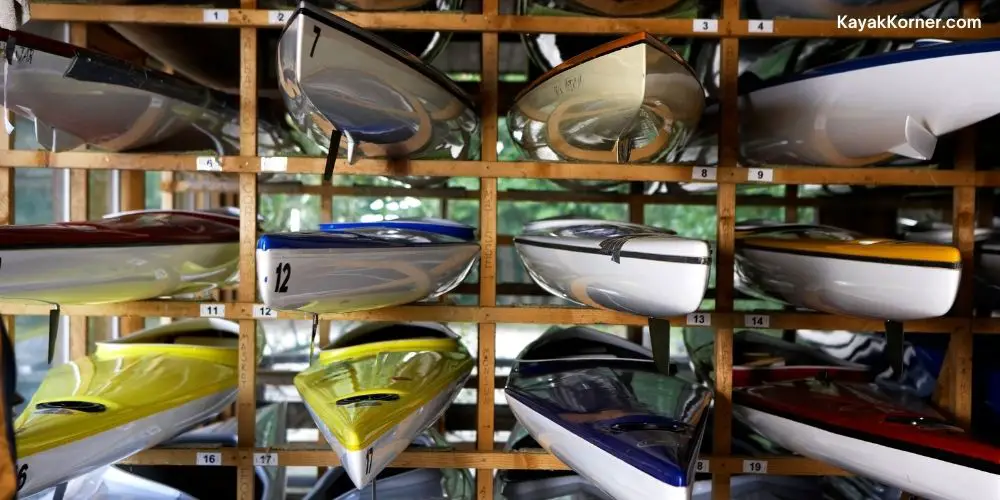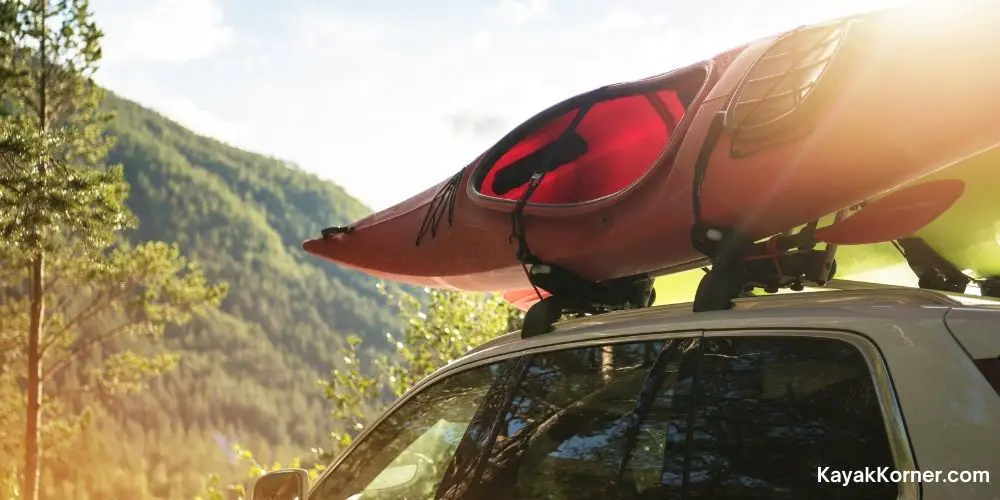If you want to keep your kayak in the best condition and protect it from any damage, knowing how to store kayaks is important.
When it comes to storing a kayak, there are some things you should keep in mind. In this article, we’ll provide you with useful information that will help you in storing your kayak properly.
First Off When Storing Kayaks
Avoid storing the kayak directly on the ground or floor since doing so for prolonged periods of time may cause deformation to a hull. Exposure to dirt and moisture when stored on the ground, can potentially harm the kayak too.
Storing A Kayak – A Rack Or Suspended?
Most paddlers usually use either the rack or suspension system for supporting their kayak.
On the rack
You can make your own rack or buy it for holding the boat off the ground. While using the rack, don’t forget to protect the boat’s hull as well. To do so, try using the rack that either allows positioning a boat hull-side up or supports a boat on its side.
Suspended
Purchase the suspension system that is designed for the kayak or try making your own one by using wide webbing straps. To ensure that you protect a hull as best as possible, hang the boat so that a hull faces up toward a ceiling. Avoid hanging a boat by grab loops because doing so may bend a boat. Instead, try using wide straps which wrap around the boat’s body.
Other Important Tips
Lock it up
Keep it protected from theft and use the lock in case you are storing it outdoors. You can also try keeping an indoor location locked, as well as protected with cameras, alarms, or any other security tools.
Keep it accessible
You should keep it somewhere that is easy to reach. Put it away carefully. Put in some effort to keep your kayak protected and safe from damage during that time.
Keep it clean
Clean your kayak well before putting it away. Clean both inside and outside and then dry it to prevent the buildup of moisture.
Distribute weight evenly
The kayak hulls may bend over or deform over time, because of the uneven weight distribution. While storing a kayak, make sure to support its weight at points along the length by using wide nylon straps matching a curve of a hull.
Don’t forget the accessories
It’s equally important to care for the extras, such as a bilge pump, spray skirt float bags, and paddle. During long-term storage, try removing all these things from a boat and rinse each with fresh water. Then let them dry and stow them indoors, if possible.
Avoid pressure points
While you are putting a boat on the rack or hanging it, do not strap it down tightly in the same way you’d while transporting it on a car. The reason is that long-term pressure from the straps may deform a kayak’s body.
Add UV protection
You can apply the sun-protective spray to hard-shell boats for providing protection from UV light.
Where You Should Store Kayaks
When it comes to storing kayaks, it’s important to keep in mind that a suitable location is the one that limits moisture, exposure to sunlight and extreme temperatures.
Moisture
If your kayak is consistently exposed to moisture from snow and rain, the hull materials may degrade over time.
Heat
Extreme heat may cause deformation of the hull materials, which means that keeping the boat away from any heat sources is of utmost importance, especially keeping it out of the very warm rooms.
Cold
Cold temperatures are not as dangerous as heat, however, repeated thawing and freezing may damage a Kayak.
Sunlight
Ultraviolet rays that accompany the bright sunlight may degrade any hull material, especially fiberglass, coated fabric, or plastic fabric.
Storing The Kayak Outside
This option can be useful for in-season use. You shouldn’t keep the boat in the water all the while ensuring it’s accessible throughout the season so that you’ll be able to quickly head out on the water.
Dock attachments are capable of keeping the kayak off the water all the while allowing easy access throughout the on-season. As long as the boat is off the water, storing it outdoors for the short term can be a good idea.
As for storing it outside for the long-term, keep the boat out of the water. It’s better to keep it under some kind of cover. Some long-term outdoor storage options can include:
- On the covered porch
- Under the deck
- Under the eaves or a roof
- With the UV-resistant as well as water-resistant kayak cover
- Under the tarp
As long as you live in a place with a mild climate, storing the kayak outdoors for the long term is not a problem. Just ensure to regularly check on it. While checking it, look if there are any signs of weather damage, moisture, or pests. Additionally, take the necessary steps for maintaining a boat that is stored outdoors, including covering, cleaning, or moving it indoors in case it is needed.
Storing The Kayak Indoors
If you have enough space, indoor storage can be the best option. Consider storing your boat in a garage, basement, shed, or any other storage area you prefer.
If you’ve got a spare room, you can house the kayak there till it is time for you to hit the water. In order to properly store it indoors, make sure to:
- Control the temperature
- Do not obstruct walking paths
- Keep the kayak away from the windows for preventing sun damage
Even though keeping the kayak indoors can be the safest choice in order to prevent theft and damage. However make sure it is not getting in your way, which might be inconvenient and in certain cases, even dangerous.
Don’t forget to hang the kayak correctly while you are storing it on the wall, or from a ceiling to avoid injury to others and damage to the kayak.
Final Thoughts
As you can see, storing your kayak depends on a lot of things, so before doing so, it’s important to take all the important factors into consideration. Once you do this, you can be sure that your kayak will remain in the best possible condition.






